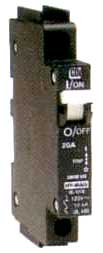Circuit Breaker Tripping Off
 AFCI (Arc Fault Circuit Interrupter)
AFCI (Arc Fault Circuit Interrupter)- GFCI (Ground Fault Circuit Interrupter)
- Overload thermal magnetic circuit breaker
What is an AFCI?
An AFCI is a product that is intended to “mitigate the affects of arcing faults” by interrupting a circuit if a potentially damaging electrical arc is detected. AFCI breakers also are incorporated with the standard overload thermal magnetic device which will also interrupt a circuit if the current exceeds the rating of the breaker.
What are “good arcs” and “bad arcs”?
Arcing is a common occurrence in circuits that occur when loads are switched as well as occurring in loads such as the brushes in a motor. This arcing has been referred to as “good arcs” since they are normal and pose no danger. On the other hand, a so-called “bad arc” can occur when wire insulation is damaged, allowing an arc to form between a conductor and either neutral or ground. These arcs are typically seen when a wire is damaged by a staple in a wall or by abuse such a crushing or cutting the wire of an extension cord. The AFCI distinguishes between these “good arcs” and “bad arcs” and de-energizes the circuit when it detects one of these potentially damaging “bad arcs”.
What is a GFCI?
A GFCI constantly monitors the electrical current passing through a circuit. If the amount of current passing into the circuit is different from the current being returned to the circuit, it indicates a ground fault and the GFCI interrupts the electrical current to the circuit. A ground fault is when an electrical current is attempting to return to ground through a source other than the wiring/circuit. An example of this would be a loose wire in a light fixture. The current could be passing through the fixture and when you touch the fixture and a grounded metal object at the same time, the current will flow through you. This could result in a fatal shock, which the GFCI is designed to prevent.
What is a thermal magnetic breaker?
A thermal magnetic circuit breaker is a device in which the electrical circuit is constantly monitored to not deliver current into the circuit past the design rating of the breaker. A short circuit or overloaded circuit will draw in excess of the breakers design and will interrupt the circuit to protect the wiring system.
What is a short circuit?
Short circuits occur when two electrical wires accidentally touch each other. A short circuit will immediately cause your circuit breaker to trip off or a fuse to blow. To fix a short circuit, ask yourself this question: “what was happening right before the breaker tripped”? If you had just plugged something into a receptacle (outlet) or turned on a light or an appliance, then this gives you a clue as to what caused the short. If you just plugged in an iron, for instance, you can simply un-plug the iron and then re-set the circuit breaker or replace the fuse. If everything is now OK, then your electrical system is fine-and it’s time to get a new iron! If, however, you can’t find anything plugged in which is causing the problem, then it’s time to call your electrician to locate and repair the short circuit.
What is a overloaded circuit?
Overloaded circuits occur when too much power is running through an electrical wire. To protect the wire, the circuit breaker does its job by detecting the overload and tripping off. The solution to this problem is to remove some of the appliances that are connected to the overloaded wires. You may wish to add one or more circuits that will help supply power to all your appliance. For this, you’ll need a good electrician.
What is a broken circuit breaker?
Sometimes circuit breakers just wear out and need to be replaced. For this, you’ll need a electrician.